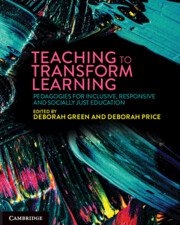Book contents
- Teaching to Transform Learning
- Acknowledgement of Country
- Teaching to Transform Learning
- Copyright page
- Contents
- Contributors
- Acknowledgements
- Introduction Understanding the learner to inform educators’ implementation of pedagogical approaches to transform learning
- Part 1 Pedagogies for all
- Part 2 Engaging pedagogies: making the curriculum come alive for all learners
- Part 3 Empowering pedagogies: 21st-century skill development and 22nd-century futures thinking
- Index
- References
Introduction - Understanding the learner to inform educators’ implementation of pedagogical approaches to transform learning
Published online by Cambridge University Press: 25 October 2024
- Teaching to Transform Learning
- Acknowledgement of Country
- Teaching to Transform Learning
- Copyright page
- Contents
- Contributors
- Acknowledgements
- Introduction Understanding the learner to inform educators’ implementation of pedagogical approaches to transform learning
- Part 1 Pedagogies for all
- Part 2 Engaging pedagogies: making the curriculum come alive for all learners
- Part 3 Empowering pedagogies: 21st-century skill development and 22nd-century futures thinking
- Index
- References
Summary
This introduction sets the scene by exploring the richness of the diversity of learners and critically examines the imperative for educators within the current educational climate to employ pedagogies that transform learning experiences, particularly for those who continue to be marginalised and are increasingly disengaged from education. The aim of the introduction is to lay the foundation for the significance of supporting educators in pedagogical decisions that prioritise and are socially just and responsive to the inclusion of all learners, thereby engaging and empowering learners as active co-designers and self-regulators of respectful, meaningful and impactful learning. In scaffolding educator efficacy, the introduction encourages self-reflective strategies for sustained critique of applying inclusive, responsive, enabling and socially just pedagogical approaches within their educational practice.
Keywords
- Type
- Chapter
- Information
- Teaching to Transform LearningPedagogies for Inclusive, Responsive and Socially Just Education, pp. 1 - 10Publisher: Cambridge University PressPrint publication year: 2024

